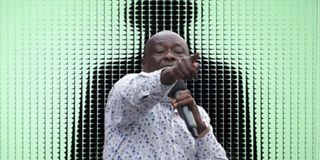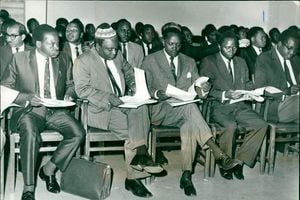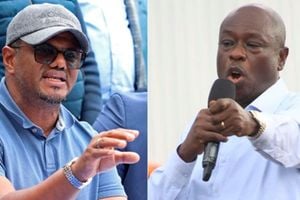
Deputy President Rigathi Gachagua.
A media invite from the National Treasury for an event last Thursday attracted a fair bit of chatter. The list of keynote speakers placed Opposition leader Raila Odinga at the top, just ahead of Prime Cabinet Secretary Musalia Mudavadi.
In a country where title and rank are obsessions amongst the leadership classes, placing Mr Odinga, who holds no government position, ahead of Mr Mudavadi, the effective number three in the pecking order behind President Wiliam Ruto and Deputy President Rigathi Gachagua, was significant.
While it could be seen as accidental or an oversight, it could also have been a very deliberate attempt to illustrate Raila’s role in the new political dispensation following the political pact with Ruto that saw the entry of nominees from his ODM party into the Kenya Kwanza coalition cabinet.
New Treasury Cabinet Secretary John Mbadi is one of the main beneficiaries of the new government structure, so the order of precedence indicated in the media invite to the Consultative Forum for Africa Green Climate Finances could well have been his individual way of acknowledging the primacy of his party leader.
But that still does not obscure the fact that Mr Odinga, even without a formal role in government, has assumed a key place at the table and will come to play a crucial role in ongoing political re-alignments on which Ruto’s 2027 re-election prospects lie.
He is assuming a position that not only elevates him above Mr Mudavadi, but also indicates the extent to which the Deputy President is being edged out of the centre of power.
It is also clear that despite his protestations that the entry of Mr Mbadi and the other ODM luminaries into the Ruto Cabinet does is not indicative of the party abandoning the opposition, the stark reality is that Mr Odinga is no longer committed to the Azimio coalition which he still nominally heads.
On Monday last week, it was reported that an Azimio Council meeting convened by former President Uhuru Kenyatta aborted after Mr Odinga’s ODM refused to participate.
A few hours before the meeting, ODM officials led by party chairman Gladys Wanga called a press conference to denounce a gathering they said could only be convened by Mr Odinga as the coalition leader, or Secretary-General Junet Mohammed. The ODM leaders expressed suspicion that the Azimio Council meeting was meant to oust Mr Raila.
The aborted meeting came as other Azimio principals — Mr Kalonzo Musyoka of Wiper Party, Mr Eugene Wamalwa of DAP-Kenya and Jeremiah Kioni of Jubilee Party—ramped up demands that ODM, the biggest affiliate party, formally quit as the Opposition leadership in Parliament since it was now part of government.
However, Mr Odinga continues to insist that ODM is still part of the Opposition, notwithstanding the appointment of Mr Mbadi, Hassan Joho (Mining and Blue Economy), Wycliffe Oparanya (Cooperatives) and Opiyo Wandayi (Energy) to the Cabinet.
A few weeks ago, Mr Odinga hosted all his co-principals in effort to explain the new arrangement. He continued to insist that his party leaders joined the Cabinet in their individual capacities and not out of any official coalition pact or political alliance.
Technically, he is right. There is no formal coalition agreement between ODM and Ruto’s UDA or the wider Kenya Kwanza alliance.
However, none of those present at the briefing, which also had the significant participation of Uhuru’s communications and political strategist Alfie Getonga, took seriously Mr Odinga’s explanation.
A source at the meeting indicated that while they did not want to outrightly challenge Mr Odinga, Mr Musyoka, Mr Wamalwa, Mr Kioni and the others left frustrated that the ODM leader wanted to have one leg in government and the other in opposition, thereby hobbling their efforts to reshape Azimio in preparation for the 2027 elections. They are also concerned that the parliamentary opposition can no longer effectively play its watchdog role as the Minority leadership which comes from ODM now sees itself as part of government.
Confusion in Azimio was played out recently when Mr Odinga claimed that it was actually Mr Kenyatta who told him to reach out to President Ruto and urge him to save the country from burning during the Gen-Z inspired revolt.
The claim was contested by Mr Kioni who has become the face of Uhuru’s Jubilee faction. But according to a key Uhuru ally, former MP David Murathe, Mr Kioni would not be in privy to private discussions between Mr Kenyatta and Mr Odinga.
While hesitant to confirm whether or not Mr Odinga’s account was accurate, Mr Murathe told The Weekly Review that there nothing wrong in Mr Kenyatta moving to steady the ship when things appear to be getting out of control. According to him, Mr Kenyatta moving to stabilise things demolishes the propaganda spewed by security agencies that he was the one funding the GenZ protests.
He also said that in terms of political power-plays, Uhuru understood the Ruto-Raila union in light of what he had also done with the Raila ‘handshake’ after the 2017 elections.
“Uhuru is aware that when you’re the president you do these things. Even he did it with Raila. Kibaki did it, Moi did it. You need to steady the ship and get numbers. People have to understand where Ruto is coming from,” he said.
However, another figure privy to Mr Odinga’s thinking, who spoke on condition of anonymity, took a different position, casting doubt on Mr Odinga’s assertion, and the implication that Mr Kenyatta supported ODM getting into government.
According to him, Mr Kenyatta remained committed to the Opposition, and his views are reflected in what Mr Kioni, as Jubilee spokesman, says.
That includes rejecting Raila’s explanations on his links with Ruto, and the need for Azimio to move ahead on presumption that it will head to the 2027 elections confronting an alliance built around the new governing alliance.
In terms of the shifting pollical formations, that brings into sharp focus Mr Gachagua’s position. The DP was the major casualty of the new arrangement, and harbours no illusions that he will be retained as Ruto’s running mate in 2027. Chances that they he might be run out of office even earlier, either through impeachment, or being forced to resign.
Mr Gachagua has been busy over the last few months trying to solidify his position in the populous Mt Kenya region, which of necessity means reaching out to Mr Kenyatta. His troops have been claiming that he has already mended fences with the former president he incessantly bashed previously, but figures close to Mr Kenyatta assert that is not quite the case.
While Mr Kenyatta is watching Mr Gachagua’s tribulations with keen interest, he is wary of approaches towards building a Mt Kenya political vehicle for benefit of an individual; or of any moves that would only serve to alienate or isolate the community, thus helping push a replay of the 41-versus1 gameplan that many suspect is what Ruto and Mr Odinga are working on.
It is for this reason that he is not publicly responding to Mr Gachagua’s overtures, and also did not get involved in the Limuru III Mt Kenya leaders conference headed Kioni and Narc Kenya leader Martha Karua.
Mr Gachagua recently issued cryptic messages of a major political move to unfold in December. He did not say what exactly is in the offing, and even his key allies and aides are remaining mum.
However, chances are that he is preparing the ground to announce his own presidential candidacy, a development with potential to entrench his quest for undisputed Mt Kenya political kingpin.
One thing Mr Gachagua has going for him is that the more Mr Ruto moves to isolate or humiliate him, the more his quest for Mt Kenya leadership gains traction. He is playing the victim card effectively, seemingly borrowing a leaf from Ruto’s playbook who as DP in the run-up to 2022 elections was frozen out by President Uhuru but exploited that to fight the establishment from within.
As alliances take shape, it is apparent that Mr Musyoka will be the most likely Azimio presidential candidate, with Wamalwa as his running mate. There will also be need for the alliance to have credible Mt Kenya figure in the equation. Ms Karua, Mr Odinga’s presidential election running-mate in 2022, would have been the most obvious choice, but she quit Azimio after the ODM leaders dalliance with Ruto, and might have thus frozen herself out.
There is thus a vacuum which Mr Gachagua could fill, and there are already whispers that he has bene in quiet consultations with Mr Musyoka
What pans out remains to be seen. Mr Odinga will most likely be in the line-up if he clinches the African Union Commission chairmanship and retires from local politics. But he could move to line up his troops under the incumbent. This will present prospects of 2027 shaping up into a Ruto-Raila (by proxy)-Mudavadi triumvirate up against a Kalonzo-Wamalwa-Gachagua (Or Karua if she gets back into the Azimio fold) group.






